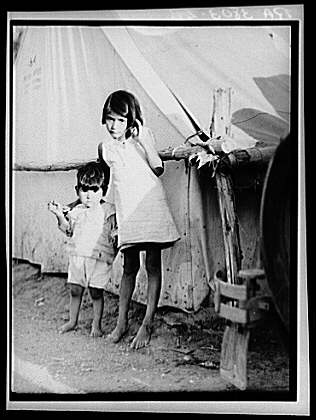
1935
"Migrant Mexican Children in Contractor's Camp at Time of Early Pea Harvest"
Photograph by Dorothea Lange
Education
Home | Education | Healthcare | History | Migratory Patterns
Law & Activism | Bibliography | Image Gallery

1935
"Migrant Mexican Children in Contractor's Camp at Time of Early Pea Harvest"
Photograph by Dorothea Lange
The transitory nature of the lives of migrant farm workers does not only affect those farm workers but also their children. In the eyes of the government, they are considered “migrant students” and so their existence is defined by their parents' occupations (2). These “migrant students” face a large number of obstacles during their school years mostly due to the mobility of their families. However, this mobility is not the only contributing factor to the poor education that these “migrant students” receive; they also are faced with poverty, difficulty of farm work and language barriers. Not to mention, schools often become associated with the government and the government associated with the fear of deportation, as a large number of farm workers in the US are undocumented.
According to statistics provided in The Human Cost of Food , nearly seventy-five percent of migrant children live below the poverty line. This poverty can affect the children in many ways not only in that they are unable to afford certain necessary school supplies. For example, when children do not receive adequate nutrition, they are unable to concentrate in class. Also, in families below the poverty level, often children must help with the household chores, which takes away from the amount of time they can devote to their schoolwork. In addition, the reason for the families place below the poverty level is often due to the lack of education of the student's parents. This implies that these parents are unable to help their children with their schoolwork, thus putting them at an even greater disadvantage. Most importantly, in situations with migrant farm workers, although education may be highly valued, one must often consider the short term benefits of having a child work or help around the home and weigh them more heavily than the long term benefits of an education.
Another important barrier with regards to education for migrant farm worker children is language. The majority of these students' first language is not English and they are often illiterate in their native language. This can make a classroom environment rather intimidating. Many schools do not have bilingual or ESL programs due to budget deficiencies and this can stunt the student's development. In addition, the language barrier can affect social situations as well as academic. Speaking another language can cause issues with making friends which is an important part of childhood. In most of these cases, the student's parents also do not speak English, which can cause communication issues between the administration and the family. Even if these parents do wish do become involved, they are one again faced with the choice of participating in their child's education or working and providing for the family.
The most obvious problem for migrant students is clearly their migratory status. As if language did not create enough of a barrier, moving from school to school can be extremely isolating for a young child. Migrant students move as often as three to five times per academic year. They have a hard time making friends, knowing that they will soon be leaving and teachers find it difficult to fully get to know their students. On an academic note, moving during the school term can cause issues with education in that the United States does not have a standardized curriculum and thus, a student could move into a classroom at a completely different academic level than they are prepared to face. This is perhaps one of the reasons why the more a student moves during the school year the more at risk they are to drop out of school (3).
In response to these problems, the federal government founded the Migrant Education Program in 1966. According to statistics from Daniel Rothenberg's ethnography With these Hands , the program costs about $350 million per year and these funds are used to hire counselors and special tutors, forming drop-out prevention programs, providing medical and dental services, arranging for transportation, and working to involve parent's more in their children's education (4). Most importantly the program created the Migrant Student Record Transfer System, which helps to transfer student records from one school to the next. According to Rothenberg, around 620,000 children currently participate in the Migrant Education program.